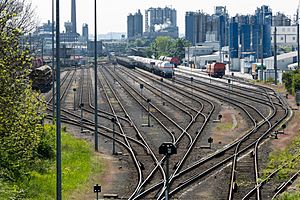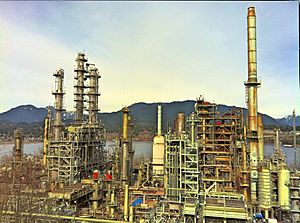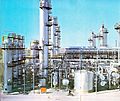Oil refining facts for kids

Oil refining is a process that changes crude oil into many useful products. Crude oil is the raw oil found deep underground. Refineries turn this raw oil into things like gasoline for cars, diesel for trucks, kerosene for jet fuel, and Liquefied petroleum gas (LPG) for cooking and heating. These changes happen at huge factories called petroleum refineries.
Refineries are very large industrial places with many different parts and machines. Each refinery is set up in its own special way. How a refinery is built depends on where it is, what products it wants to make, and how much money it costs. Some modern refineries can process a huge amount of crude oil every day – hundreds of thousands of barrels!
Contents
What is Crude Oil?
Crude oil is a thick, dark liquid found beneath the Earth's surface. It's a mix of many different chemicals. Before it can be used, it needs to be cleaned and separated into its different parts. Think of it like a giant smoothie with many ingredients that need to be pulled apart.
Why Do We Refine Oil?
We refine oil because crude oil itself isn't very useful on its own. It's a messy mix. By refining it, we can separate it into valuable products that power our cars, heat our homes, and even make plastics and other materials we use every day. It's like taking a raw material and turning it into finished goods.
How Oil Refineries Work
Oil refineries use many steps to change crude oil into useful products. The main process is called distillation.
Distillation: Separating the Mix
Imagine heating a pot of water. The water turns into steam, but any salt in the water stays behind. Distillation works in a similar way.
- First, crude oil is heated to very high temperatures.
- It then turns into a hot vapor (a gas).
- This vapor goes into a tall tower called a fractionation column.
- As the vapor rises in the tower, it cools down.
- Different parts of the oil cool and turn back into liquid at different heights in the tower.
- Lighter products like gasoline rise to the top, while heavier products like asphalt stay at the bottom. This separates the crude oil into different "fractions" or parts.
Other Important Processes
After distillation, the different parts of the oil might go through more steps:
- Cracking: This process breaks down heavier, less useful oil parts into lighter, more valuable ones, like gasoline. It's like breaking a big LEGO structure into smaller, more useful pieces.
- Treating: This removes impurities (unwanted things) like sulfur from the oil products. Sulfur can cause pollution, so it's important to take it out.
- Blending: Finally, different refined products are mixed together to create the final products, like different grades of gasoline.
Products Made from Oil
Refineries make many products we use daily. Here are some of the most common:
- Gasoline: Used to power most cars.
- Diesel fuel: Used for trucks, buses, trains, and some cars.
- Kerosene: Used for jet fuel, heating oil, and lamps.
- Liquefied Petroleum Gas (LPG): Used for cooking, heating, and sometimes in vehicles.
- Fuel oils: Used for heating homes and powering ships or industrial furnaces.
- Lubricants: Like motor oil, which keeps engines running smoothly.
- Asphalt: Used to make roads.
- Petrochemicals: These are chemicals made from oil that are used to create plastics, fertilizers, medicines, and many other products.
Safety in Refineries
Because refineries handle flammable materials and use high temperatures and pressures, safety is extremely important. Refineries have strict rules and special equipment to prevent accidents and protect workers and the environment.
Images for kids
-
Anacortes Refinery (Marathon), in Anacortes, Washington, United States.
-
A petrochemical refinery in Grangemouth, Scotland.
-
The oil refinery in Haifa, Israel, can process about 9 million tons of crude oil a year. Its two cooling towers are landmarks.
-
Storage tanks and towers at Shell Puget Sound Refinery (Shell Oil Company), Anacortes, Washington.
-
Refinery of Slovnaft in Bratislava.
-
Sample of crude oil (petroleum).
-
Cylinders of liquified petroleum gas.
-
Sample of gasoline.
-
Sample of kerosene.
-
Sample of diesel fuel.
-
Pile of asphalt-covered aggregate for formation into asphalt concrete.
See also
 In Spanish: Refinería de petróleo para niños
In Spanish: Refinería de petróleo para niños




















